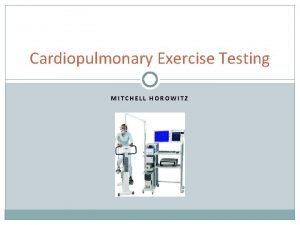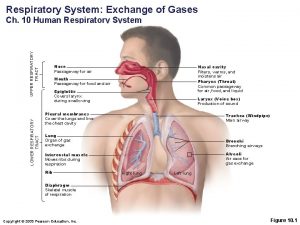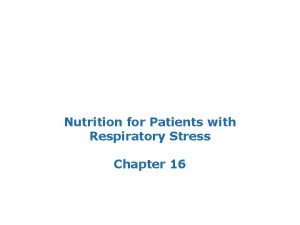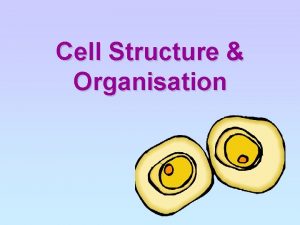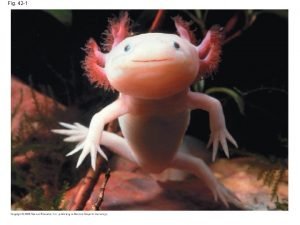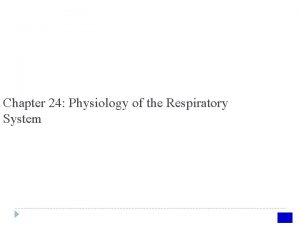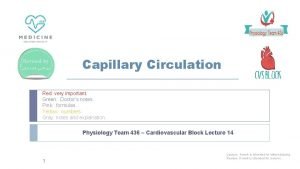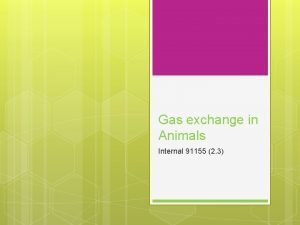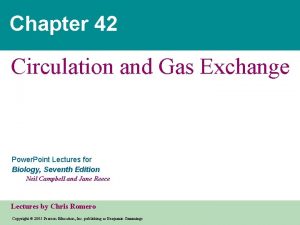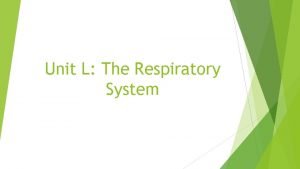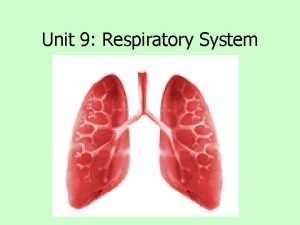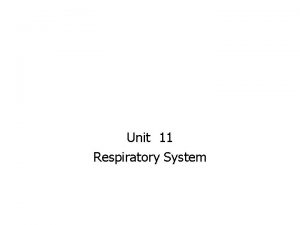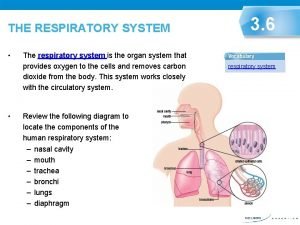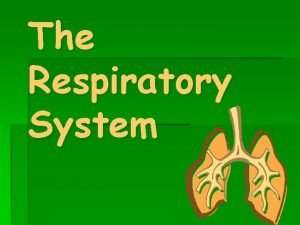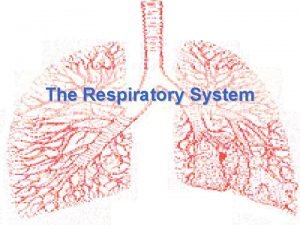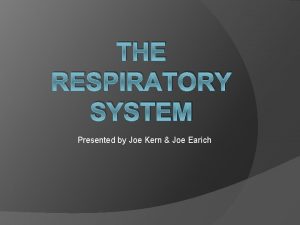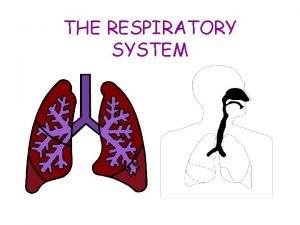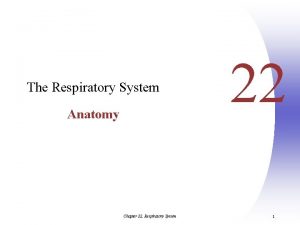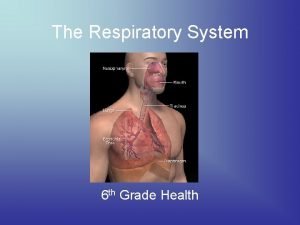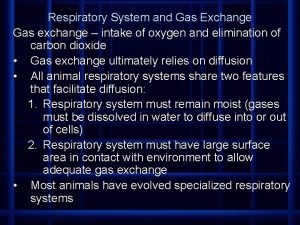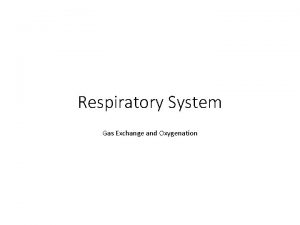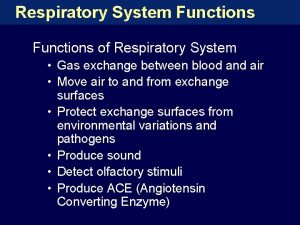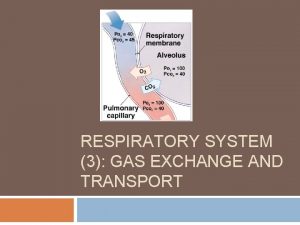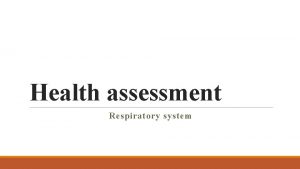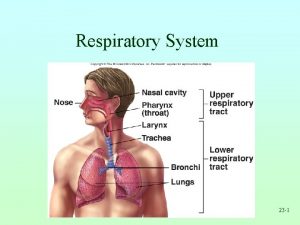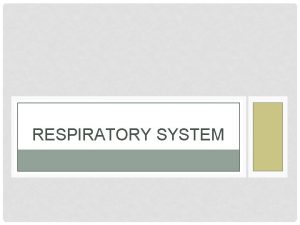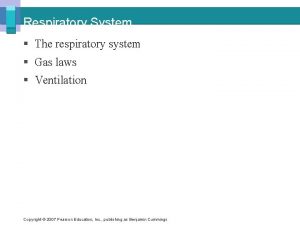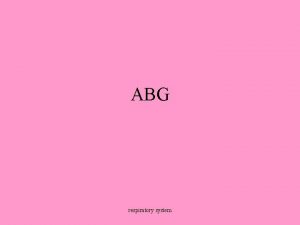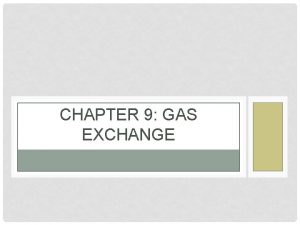Gas Exchange and The Respiratory System Gas Exchange




























- Slides: 28

Gas Exchange and The Respiratory System

Gas Exchange in Animals • Gas exchange = taking in molecular oxygen (O 2) from the environment and disposing of carbon dioxide (CO 2) to the environment.

Gas Exchange • Cellular respiration is the breakdown of organic molecules to make ATP. A supply of oxygen is needed to convert stored organic energy into energy trapped in ATP. • Carbon dioxide is a by-product of these processes and must be removed from the cell. • There must be an exchange of gases: carbon dioxide leaving the cell, oxygen entering.

Air Supply • The respiratory medium or source of oxygen is: 1. Terrestrial Animals = air 2. Aquatic Animals = water. • • Atmosphere is ~21% oxygen (O 2) Bodies of water – variable oxygen content, but much less than in an equal amount of air.


Respiratory Surface • Gases are exchanged with the environment at the respiratory surface. • Gas movement is by diffusion. • Respiratory surfaces are usually thin and have large areas as well as adaptations to facilitate the exchange. • Gases are dissolved in water, so respiratory surfaces must be moist.

Diffusion Rate • The net diffusion rate of a gas across a fluid membrane is – proportional to the difference in partial pressure, – proportional to the area of the membrane and – inversely proportional to the thickness of the membrane.

Fick’s Law • The rate at which a substance can diffuse is given by Fick's law

Surface to Volume Ratio • Rate of exchange of substances depends on the organism's surface area that is in contact with the surroundings. • The ability to exchange substances depends on the surface area : volume ratio. • As organisms get bigger, their volume and surface area both get bigger, but volume increases much more than surface area.


Terrestrial Respiratory Systems • Many terrestrial animals have their respiratory surfaces inside the body and connected to the outside by a series of tubes. • Insects, centipedes, and some mites and spiders have a tracheal respiratory system. • Vertebrates have lungs.

Human Respiratory System

Human Respiratory System • This system includes the lungs, pathways connecting them to the outside environment, and structures in the chest involved with moving air in and out of the lungs. • The main task of any respiratory system is to take in oxygen and remove carbon dioxide.

Lungs • Lungs are ingrowths of the body wall and connect to the outside by as series of tubes and small openings. • Lung breathing probably evolved about 400 million years ago. • Lungs are not entirely the sole property of vertebrates, some terrestrial snails have a gas exchange structures similar to those in frogs.

• The lungs are large, lobed, paired organs in the chest (also known as the thoracic cavity). • Thin sheets of epithelium (pleura) separate the inside of the chest cavity from the outer surface of the lungs. • The bottom of the thoracic cavity is formed by the diaphragm.

Pathway of Air • Air enters the body through the nose, is warmed, filtered, and passed through the nasal cavity. • Air passes the pharynx (which has the epiglottis that prevents food from entering the trachea). • The upper part of the trachea contains the larynx. The vocal cords are two bands of tissue that extend across the opening of the larynx. • After passing the larynx, the air moves into the bronchi that carry air in and out of the lungs.

• Bronchi are reinforced to prevent their collapse and are lined with ciliated epithelium and mucus-producing cells. • Bronchi branch into smaller and smaller tubes known as bronchioles. • Bronchioles terminate in grape-like sac clusters known as alveoli. • Alveoli are surrounded by a network of thin -walled capillaries. Only about 0. 2 µm separate the alveoli from the capillaries due to the extremely thin walls of both structures.


Alveoli • Only in the alveoli does actual gas exchange takes place. • There are some 300 million alveoli in two adult lungs. • These provide a surface area of some 160 m 2 (almost equal to the singles area of a tennis court and 80 times the area of our skin!).

Alveoli

Diffusion of O 2 and CO 2

Alveoli: Designed for Rapid Gas Exchange • After branching repeatedly the bronchioles enlarge into millions of alveolar sacs • This arrangement produces an enormous surface are for gas exchange • Each alveolus is surrounded by a net of capillaries • The diffusion distance from gas in the alveoli to blood cells in the capillaries is very short • Blood takes about 1 second to pass through the lung capillaries • In this time the blood becomes nearly 100% saturated with oxygen and loses its excess CO 2

Surfactants Prevent the Alveoli From Collapsing • At air/water interfaces there is a high surface tension • The high surface tension would cause the alveoli to collapse, but this is prevented by surfactants • Surfactants are detergent-like phospholipids which accumulate at the air/water interface and lower the surface tension • Reduced surfactant causes respiratory distress syndrome (seen in premature infants and some older persons)

Pigments • Respiratory pigments increase the oxygencarrying capacity of the blood. Humans have the red-colored pigment hemoglobin as their respiratory pigment. • Hemoglobin increases the oxygen-carrying capacity of the blood between 65 and 70 times. • Each red blood cell has about 250 million hemoglobin molecules, and each milliliter of blood contains 1. 25 X 1015 hemoglobin molecules. • Oxygen concentration in cells is low (when leaving the lungs blood is 97% saturated with oxygen), so oxygen diffuses from the blood to the cells when it reaches the capillaries.

Ventilation • Ventilation is the mechanics of breathing in and out. • When you inhale, muscles in the chest wall contract, lifting the ribs and pulling them, outward. The diaphragm at this time moves downward enlarging the chest cavity. Reduced air pressure in the lungs causes air to enter the lungs. • Exhaling reverses theses steps.

Negative Pressure Breathing

Diaphragm Action

Negative Pressure Animation
 Gas exchange key events in gas exchange
Gas exchange key events in gas exchange Conducting zone of the respiratory system function
Conducting zone of the respiratory system function Respiratory digestive and circulatory system
Respiratory digestive and circulatory system Circulatory system and respiratory system work together
Circulatory system and respiratory system work together Tiny air sacs at the end of the bronchioles
Tiny air sacs at the end of the bronchioles Fick equation
Fick equation Gas exchange in circulatory system
Gas exchange in circulatory system Upper and lower respiratory tract
Upper and lower respiratory tract Respiratory stress
Respiratory stress Identify the cell
Identify the cell Respiratory system in humans
Respiratory system in humans Fig 42
Fig 42 Pulmonary gas exchange and transport diagram
Pulmonary gas exchange and transport diagram Arterial vs venous end of capillary
Arterial vs venous end of capillary Gas exchange in plants and animals venn diagram
Gas exchange in plants and animals venn diagram Chapter 42 circulation and gas exchange
Chapter 42 circulation and gas exchange Respiratory system bozeman
Respiratory system bozeman Unit 9 respiratory system
Unit 9 respiratory system Diagnostic test of respiratory system
Diagnostic test of respiratory system What is the respiratory system
What is the respiratory system Respiratory system larynx
Respiratory system larynx Respiratory system coloring page
Respiratory system coloring page Respiratory system purpose
Respiratory system purpose Conclusion of the respiratory system
Conclusion of the respiratory system Respiratory system jobs
Respiratory system jobs Cengage learning chapter 7 answers
Cengage learning chapter 7 answers Respiratory tree divisions
Respiratory tree divisions Chapter 22 respiratory system
Chapter 22 respiratory system Interesting facts about respiratory system
Interesting facts about respiratory system





